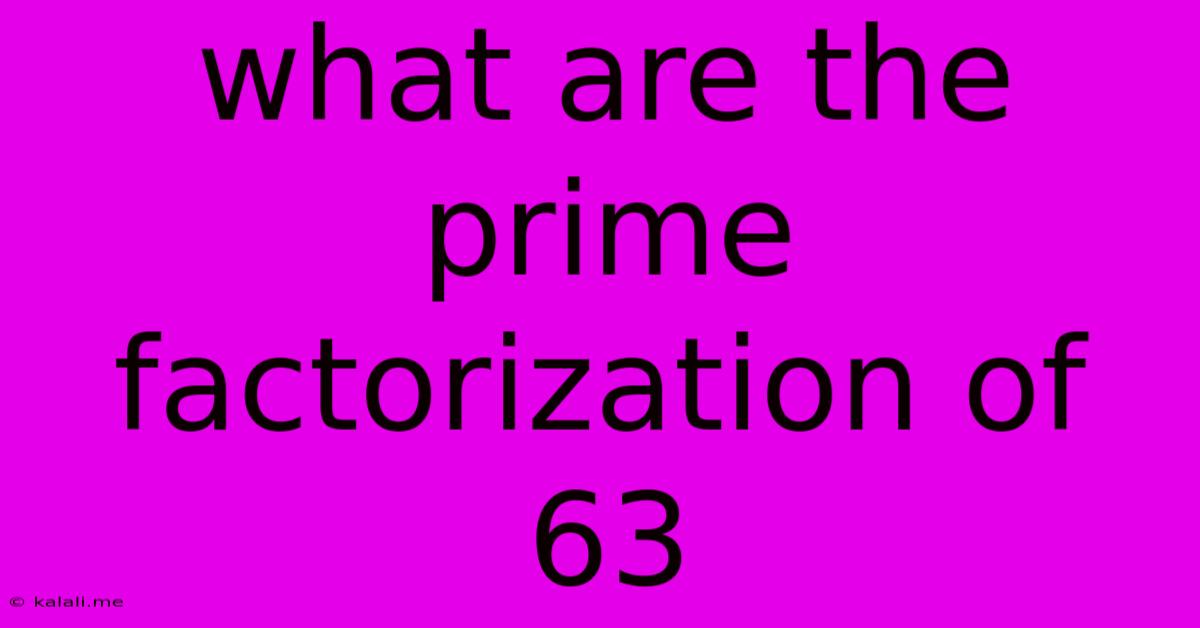What Are The Prime Factorization Of 63
Kalali
Jun 14, 2025 · 2 min read

Table of Contents
What are the Prime Factorization of 63? A Step-by-Step Guide
Finding the prime factorization of a number is a fundamental concept in mathematics, particularly useful in simplifying fractions, finding least common multiples (LCM), and greatest common divisors (GCD). This article will guide you through the process of determining the prime factorization of 63, explaining the method clearly and concisely. Understanding this process will improve your mathematical skills and boost your understanding of number theory.
What is Prime Factorization?
Prime factorization is the process of expressing a number as a product of its prime factors. A prime number is a whole number greater than 1 that has only two divisors: 1 and itself. Examples of prime numbers include 2, 3, 5, 7, 11, and so on. The prime factorization of a number is unique; meaning there is only one way to express it (disregarding the order of the factors).
Finding the Prime Factorization of 63
To find the prime factorization of 63, we'll use a method of repeated division by prime numbers. We start by dividing 63 by the smallest prime number, 2. Since 63 is not divisible by 2 (it's an odd number), we move to the next prime number, 3.
-
Divide by 3: 63 ÷ 3 = 21
-
Divide 21 by 3: 21 is also divisible by 3. 21 ÷ 3 = 7
-
Divide by 7: 7 is a prime number. Therefore, the process ends here.
Therefore, the prime factorization of 63 is 3 x 3 x 7, or more concisely written as 3² x 7.
Alternative Methods:
While the method above is straightforward, you can also use a factor tree to visualize the prime factorization. A factor tree starts with the original number (63) and branches out, showing its factors until only prime numbers remain at the end of each branch. The prime numbers at the end of the branches are then multiplied together to get the prime factorization.
Applications of Prime Factorization:
Understanding prime factorization has various applications in mathematics, including:
- Simplifying Fractions: Finding the GCD of the numerator and denominator allows for simplification.
- Finding LCM: The LCM is crucial in solving problems involving fractions and determining periodic events.
- Cryptography: Prime numbers play a vital role in modern cryptography systems.
- Number Theory: Prime factorization forms the basis of many theorems and concepts within number theory.
Conclusion:
The prime factorization of 63 is 3² x 7. Understanding how to find the prime factorization of a number is a valuable skill with various applications across different mathematical fields. By mastering this fundamental concept, you'll gain a deeper understanding of number theory and improve your problem-solving abilities. Remember to practice with different numbers to solidify your understanding.
Latest Posts
Latest Posts
-
What Day Of The Week Is November 17th
Jun 15, 2025
-
Largest Freshwater Lake In World By Volume
Jun 15, 2025
-
A Person Who Believes Everything Easily
Jun 15, 2025
-
Which Of The Following Defines The First Law Of Thermodynamics
Jun 15, 2025
-
25 Of What Number Is 6
Jun 15, 2025
Related Post
Thank you for visiting our website which covers about What Are The Prime Factorization Of 63 . We hope the information provided has been useful to you. Feel free to contact us if you have any questions or need further assistance. See you next time and don't miss to bookmark.